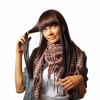|
 Strange as
it may seem, hair straightening is a burning hot issue with the fairer sex. As
you may know, demand breeds supply, so many beauty salons offer hair
straightening services, and manufacturers of hair care products offer whole lines
of hair straightening products. Electrical appliance manufacturers were prompt
to follow with hair straightening devices (commonly known as «hair irons»). Let's
learn more about all these hair straightening options. Strange as
it may seem, hair straightening is a burning hot issue with the fairer sex. As
you may know, demand breeds supply, so many beauty salons offer hair
straightening services, and manufacturers of hair care products offer whole lines
of hair straightening products. Electrical appliance manufacturers were prompt
to follow with hair straightening devices (commonly known as «hair irons»). Let's
learn more about all these hair straightening options.
Chemical Hair
Straightening
As you
know, your hair is a protein-based structure. Sulfur bonds in the chemical
composition of hair create curls. That is why to straighten your hair you must destroy
these chemical bonds. Chemical hair straightening is not a difficult procedure,
but it does require a thorough technical knowledge of the relaxing process. Therefore
it should always be performed by a hair care professional with a track record
of success with straightening. The stylist will also need to evaluate current
hair texture, porosity, elasticity and the presence or absence of any hair
damage. A good professional will also keep detailed records of any chemical treatments
that have been performed on the hair and can use those written records to
determine the best course of treatment.
Strong
chemicals are applied to the hair, directly on the hair shaft. There are
generally two solutions: one to break down the keratin protein bonds in the
hair, the other to reset the bonds after the hair has been straightened.
The first
solution is applied on dry hair. Then it is carefully combed through the hair,
taking care not to stretch it. The hair is extremely fragile during this time
and should not be disturbed too much. The solution is generally left on for
about 5 to 8 minutes, depending on the hair type and the type of chemical hair
straightening solution used.
Once the
stylist determines that the keratin bonds are free from their curly nature,
s/he will remove the first solution and apply the second, to reset the bonds in
the new, straight formation.
After the
procedure, it's important to follow your stylist's instructions about
after-care. The hair will be fragile and prone to excess breakage. A protein
rich shampoo will help maintain the hair's elasticity and shine and increase
its strength. Replace moisture by conditioning after each shampoo and weekly
reconstructing treatments. Use a quality leave-in conditioner for detangling if
necessary.
Depending
on your hair growth, touch up applications should be done about twice a year.
Avoid further chemical treatments, like bleach or permanent hair coloring. If
you need to color your hair, use a semi-permanent. They're much gentler on the
hair and may actually help to improve the appearance of damaged hair by adding
shine and evening out color.
Although
chemical hair straightening can dramatically reduce your styling time, there's
still a lot of effort required to keep your hair looking good and minimize damage.
Mechanical Hair
Straightening
By
mechanical hair straightening we mean straightening of hair with special flat styling
irons (ironing), and blow-drying with the hair brush. Hair straightening irons
have wide plates to accommodate large sections of hair. These ceramic-coated
plates divide heat evenly and prevent damage to the hair. The nylon comb
attachment holds the hair taut during the straightening process to give better
results. These straightening irons offer different heat settings to suit various
hair types. The ceramic technology allows gentle infrared heat and negative
ions that will result in frizz-free hair. Hot pressing irons have been used for
straightening hair since nearly a century now. To use a hair straightening
iron, you need to wash your hair and towel dry it. Regular deep conditioning of
the hair can give it a healthier bounce and shine. Use good detangling products
and wide -toothed comb for the hair after a straightening treatment. To prevent
damage to the thermally straightened hair, you need to use styling products
designed specifically for thermally treated hair, as they contain active
substances that work under high temperatures.
If you
straighten your hair well with a brush and hair dryer, select a brush with natural
bristle and a comfortable handle. And remember: the longer the hair, the wider
the diameter of the brush.
Here are
some basic hair straightening tips:
- Use special
care products: shampoo, conditioner, and styling solutions. There is no point
in using a shampoo designed for curly or frizzy hair and trying to straighten it
afterwards. When blow-drying and ironing
your hair, use styling products to protect your hair, otherwise it will soon lose
its luster and elasticity.
- Ensure regular
care. All hair care and styling products should be use on a regular basis, not
from time to time. It is necessary to ensure extra care and nourishment of hair
(with masks, serums). Also, you should have your hair cut regularly to get rid
of weakened and frizzy hair.
- Love and protect
your hair. If you want to have lustrous healthy straight hair, you need to protect
it from any unnecessary exposure. Before going out in direct sunlight apply
hair spray with UV protection, and protect your hair from the rain, avoid high
humidity, as it contributes to the formation of curls.
As you see,
both chemical and mechanical types of hair straightening have their advantages
and disadvantages. So the best thing to do is to consult a dermatologist or
hair stylist regarding this matter.
|